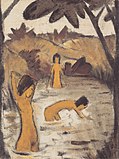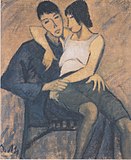Otto Mueller
Otto Mueller | |
|---|---|
 Otto Müller, Self-Portrait, c. 1921, Saint Louis Art Museum | |
| Born | 16 October 1874 |
| Died | 25 September 1930 (aged 55) |
| Nationality | German |
| Education | Academy of Fine Arts, Dresden, Academy of Fine Arts, Munich |
| Known for | Painting, printmaking |
| Style | Expressionism |
| Movement | Die Brücke |

Otto Müller (16 October 1874 – 24 September 1930) was a German painter and printmaker of the Die Brücke expressionist movement.
Life and work
Mueller was born in Liebau (now Lubawka, Kamienna Góra County), Kreis Landeshut, Silesia. Between 1890 and 1892 he was trained in lithography in Görlitz and Breslau. From 1894 to 1896 he studied at the Academy of Fine Arts in Dresden under Georg Freyer and continued his study in Munich during 1898. He left Munich's academy after Franz von Stuck classified him as untalented.[citation needed]
His early works are influenced by impressionism, Jugendstil and Symbolism. However, much of his early work is lost due to his own destruction of his early pieces.[1] When he settled to Berlin in 1908, his style became more expressionist. During this time there were meetings with Wilhelm Lehmbruck, Rainer Maria Rilke and Erich Heckel. In 1910, he joined 'Die Brücke', a Dresden-based group of Expressionist artists. He was member of the group until it disbanded in 1913 due to artistic differences. At the same time Mueller also had contact with the artists group 'Der Blaue Reiter'.[citation needed] Mueller was known as incredibly antibourgeois and is said to have urinated on the floor of a middle-class household when he was invited for a dinner party.[1]
During World War I he fought as a German soldier in France and Russia. After the war he became a professor at the Academy of Arts (Akademie der Bildenden Kunste) in Breslau where he taught until his death on 24 September 1930. Johnny Friedlaender and Isidor Ascheim were among his pupils there.
In 1937 the Nazis seized 357 of his works from German museums as "degenerate art".[2][3] They also looted Mueller' artworks from Jewish collectors like the Littmanns.[4][5][6] Other Muellers were lost or stolen during the war[7] Several artworks by Mueller turned up in the Gurlitt hoard.[8][9][10]
Mueller was one of the most lyrical of German expressionist painters. The main topic of Mueller's works is the unity of humans and nature; his paintings emphasize a harmonious simplification of form, colour and contours. He is known especially for his characteristic paintings of nudes and Romani women; his nickname was "Gypsy Mueller" and his mother was perhaps Romani.[2] Mueller was a huge fan of Egyptian art, and likened his use of simple clean lines to the ancient style.[1] The medium he preferred for his paintings was distemper on coarse canvas, which produced a mat surface.[11] Altogether his printmaking amounted to 172 prints, nearly all of them lithographs, but including a few woodcuts and etchings.
Works
-
Self-portrait with guitar, 1903–04, oil on canvas, 76 × 65 cm, private collection
-
Three bathing women in the pond, c. 1912, glue paint on plucking, 119 x 90 cm, Museum am Ostwall, Dortmund
-
Brücke, 1912, wood-print on paper, on cover
-
Two Lovers (Liebespaar), c. 1914, glue paint on plucking, 101.5 x 83.5 cm, private collection
-
Landscape with Yellow Nudes, c. 1919, oil on burlap, 70.2 x 90.8 cm, MoMA
-
Three Nudes in a Landscape (Drei Akte in Landschaft', 1919, tempera on canvas, Brücke Museum, in Berlin
-
Mother and Child 2. (Mutter und Kind 2.), 1920, lithograph on paper, 26 x 18.7 cm
-
Three Figures (Drei Akte)), c. 1925, watercolor and colored chalk on paper, 68 x 50 cm, Museum am Ostwall, Dortmund
-
Forest with flowers and pond, c. 1925, distemper on jute, 106.5 x 77 cm
-
Gypsy horse at black water, 1928, Germanisches Nationalmuseum
Notes
- ^ a b c Barnstone, Deborah Ascher (2016-06-28). Beyond the Bauhaus: Cultural Modernity in Breslau, 1918-33. University of Michigan Press. doi:10.2307/j.ctt1gk088m.10. ISBN 978-0-472-90059-6. Retrieved 8 October 2023.
- ^ a b Wolf 2006, p. 76
- ^ "Fateful Choices: Art from the Gurlitt Trove at the Israel Museum Presents Some 100 Significant Works Amassed by Dr. Hildebrand Gurlitt". www.lootedart.com. Retrieved 2021-05-21.
One of the most significant paintings in the exhibition, Portrait of Maschka Mueller by Otto Mueller (1924-25) was branded "degenerate" by the Nazis and acquired by Gurlitt in 1941.
- ^ "Provenance Research: Museum Ludwig, Köln (Ludwig Museum, Cologne)". www.lootedart.com. Retrieved 2021-05-21.
Museum Ludwig, Köln (Ludwig Museum, Cologne) Research into Nazi-confiscated works of art in the museum's collection In 1999 the museum returned the painting Zwei weibliche Halbakte (Two Female Nudes ) (1919) by Otto Mueller to the heirs of Dr. Ismar Littmann. The work had entered the collection of the Wallraf-Richartz Museum in 1946 as part of a gift from Cologne collector Josef Haubrich. When the modern art Museum Ludwig was created in 1976, the 20th century collection of the Wallraf-Richarz Museum was transferred into it, and the Otto Mueller painting became integrated into the collection of the Museum Ludwig. The painting was originally part of the collection of Breslau (Wroclaw) collector Dr. Ismar Littmann (1878-1934), who met Otto Mueller when the latter was nominated professor at the local School of Art and Design. In 1934 Littmann committed suicide. In February 1935 his widow put the collection up for auction through the dealer Max Perl, Berlin. But two days before the auction sixty-four Littmann works were confiscated by the Gestapo, including this painting by Mueller, which was among the few works chosen by Eberhard Hanfstaengl, director of the Nationalgalerie, when he was asked to choose those with "sale value". Most of the others, if not all, are believed to have been burnt. In 1937 the painting was confiscated from the Nationalgalerie as "degenerate art" and displayed at the eponymous Munich exhibition that same year. In 1939 it was put up for sale in the auction of 'Paintings and Sculpture by Modern Masters from German Museums' at the Fischer Gallery in Lucerne, Switzerland. Unsold, it was returned to Germany, where the art dealer Hildebrand Gurlitt purchased it for $100, selling it to Josef Haubrich two years later. Before being alerted to its real provenance in 1998, the Museum Ludwig states it had no reason to suspect the painting's history as it was registered as originating from the Nationalgalerie, Berlin.
- ^ "Kunsthalle in Emden, (Emden Art Gallery)". www.lootedart.com. Retrieved 2021-05-21.
Kunsthalle in Emden, (Emden Art Gallery) Research into Nazi-confiscated cultural property in the museum's collection. The museum was involved in the first restitution of a painting from the Littmann collection. The painting Knabe vor zwei stehenden und einem sitzenden Mädchen (Landschaft mit Figuren) (1918/19) by Otto Mueller was then part of the collection of Henri Nannen who created a foundation in 1983 which led to the opening of the Emden museum in 1986. Nannen had bought the painting from an English dealer in 1979 and remembered seeing the painting before at the 1937 "Entartete Kunst" exhibition in Munich. The painting had originally been part of the collection of the Breslau (Wroclaw) collector Dr. Ismar Littmann (1878-1934) who met Otto Mueller when the latter was nominated professor at the local School of Art and Design. In 1934 Littmann committed suicide; his widow then put the collection up for auction through the Berlin dealer Max Perl. Two days before the auction sixty-four works from the collection were confiscated by the Gestapo, including this painting by Mueller. The Otto Mueller painting was kept at the Nationalgalerie as of "sale value" but most of the others are believed to have been burnt. In 1937 the painting was confiscated from the Nationalgalerie as "degenerate art" and displayed at the defamatory Munich exhibition, after which it was given to the art dealer Bernhard Boehmer for a trifling amount.
- ^ "Looting and Restitution. Jewish-Owned Cultural Artifacts at the Jewish Museum Berlin". www.lootedart.com. Retrieved 2021-05-21.
Otto Mueller's painting entitled "Boy with two standing girls and one sitting girl" belongs to the paintings whose journey was traceable from looting to recovery. The Gestapo confiscated it from the auction of Ismar Littmann's art collection in Breslau in 1935. It was then shown at the "Entartete Kunst" (Degenerate Art) exhibition in Munich in 1937, after which it was sold. Ismar Littmann's heirs arranged to repurchase it from the Emden Kunsthalle, Henri and Eske Nannen Foundation in 1999.
- ^ "Art Case Alleges WW II-Era Double-Cross". www.lootedart.com. Retrieved 2021-05-21.
Four of the paintings that Weidler did not sell are still in the Yris Rabenou Gallery's custody, including Max Pechstein's "Portrait of Paul Westheim," Otto Mueller's "Bathers," Edgar Jene's "Plastische Imagination" and a watercolor by Paul Klee, according to the complaint.
- ^ "Dual exhibitions lift veil on Nazi-era art hoard". www.lootedart.com. Retrieved 2021-05-21.
"Maschka" by Otto Mueller, one of the works found in the horde belonging to the German collector Cornelius Gurlitt, in the restoration studio at the Kunstmuseum Bern in Switzerland for the "Gurlitt: Status Report" shows Portions of the spectacular art collection hoarded by the son of a Nazi-era dealer will be shown for the first time since World War II in parallel exhibitions in Switzerland and Germany starting Thursday.
- ^ "U.S. List Helps Heirs Track Nazi-Loot Art in Munich Cache". www.lootedart.com. Bloomberg. Retrieved 2021-05-21.
Other works in Gurlitt's collection in 1950 included paintings by Emil Nolde, Hans Thoma, Otto Mueller, George Grosz, Karl Schmidt-Rottluff, August Macke and the Italian painter Guardi.
- ^ "Conservators remove fungus and cobwebs from Gurlitt hoard". www.lootedart.com. Archived from the original on 2018-05-01. Retrieved 2021-05-21.
- ^ Wolf 2006, p. 76; Moeller 2001, p. 77
References
- Moeller, Magdalena M. The Brücke Museum, Berlin. Prestel, 2001.
- Wolf, Norbert. Expressionism. Taschen, 2006.
External links
- Available Works & Biography Galerie Ludorff, Düsseldorf, Germany









